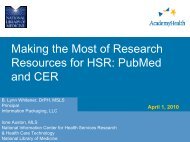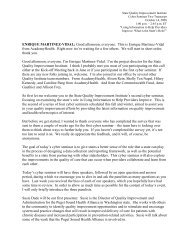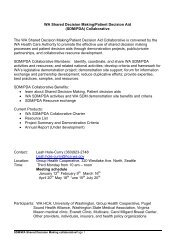Ohio Health Quality Improvement Plan
Ohio Health Quality Improvement Plan
Ohio Health Quality Improvement Plan
You also want an ePaper? Increase the reach of your titles
YUMPU automatically turns print PDFs into web optimized ePapers that Google loves.
In f o r m e d a n d ActivatedPa t ie n t s a n d In d iv id u a l s▪▪Ascertain benefit coverage restrictions or incentives such as mental health benefits limitations, precertificationrequirements, access restrictions to specialists or adjunct health providers, variables in co-paysfor specific types of care or providers before seeking treatment.• Promote broad public access to and use of webCHAT Choosing <strong>Health</strong>plans All Together, an abbreviated internetversion of the research and educational tool used by the <strong>Ohio</strong> Department of Insurance to determine what uninsured<strong>Ohio</strong>ans think a “basic” health plan must offer. 15<strong>Health</strong> Care Treatment DecisionsTo be effective, information and decision supports related to health care treatment should be offered in understandableformats and take into account the range of health literacy levels and decision-making skills found in society.• Commission the development and testing of skill-building tools, which support health care treatment decision-making,patient activation, patient/provider care teams and self-management.Action Steps◦◦ Identify and facilitate access to culturally and linguistically appropriate tools and practices that have beendemonstrated to support patient engagement and self management.◦◦ Identify and facilitate use of proven, culturally and linguistically appropriate strategies and tools to enablepatients to understand all treatment options and to make decisions consistent with their values and preferences.◦◦ Develop and test culturally and linguistically appropriate tools, strategies or practices if they are not already inexistence.• Develop and implement a “shared decision-making” pilot in one or more of the state controlled medical plans (e.g.,Medicaid, state employee health plan), or in conjunction with early medical home initiatives with an initial focus ona few common expensive conditions where there are multiple treatment options. Key strategies supportive of patientself-management include identifying and disseminating evidence-based self management practices; recognizing thecentrality of self-management to good patient care and incorporating it into health care culture; developing programsand tools applicable to diverse populations; providing incentives for integrating the appropriate self managementsupports into the delivery of health care; and making better use of all members of the health care team.Action Steps◦◦ Identify and prioritize the high prevalence/high cost conditions to target.◦◦ Identify evidence-based self-management practices, disease-specific education programs and patient aids.◦◦ Establish a clearinghouse of patient education, self-management and decision-making tools.◦◦ Identify disease- and/or condition-specific tools that are evidence-based, age, culturally, and linguisticallyappropriate.◦◦ Make tools readily available to patients through marketing campaigns, Web sites, distribution through PCMHsand community organizations.◦◦ Propose incentives for integrating the appropriate use of self management supports into the delivery of healthcare.16• Develop and implement a pilot “academic pharmaceutical detailing” program in one or more of the state controlledmedical plans (e.g., Medicaid, state employee health plan), to provide independent information and support to15 CHAT TM is a computer simulation game, which was developed by physician ethicists at the National Institutes of <strong>Health</strong> and the University of Michigan.CHAT simulates the challenges in making decisions about health plan benefits packages when there are more choices than resources.16 Academic detailing is “university-based educational outreach.” The process involves face-to-face education of prescribers by trainedhealth care professionals, typically pharmacists, physicians, or nurses. The goal of academic detailing is to change prescribing of targeteddrugs to be consistent with medical evidence, support patient safety, and to be cost-effective medication choices. A key component ofuniversity-based academic detailing programs is that they (academic detailers, management, staff, program developers, etc.) do not haveany financial links to the pharmaceutical industry. For more information on academic detailing visit:http://www.prescriptionproject.org/tools/fact_sheets/files/0007.pdfSee also A Template For Establishing And Administering Prescriber Support And Education: A collaborative, service-based approach forachieving maximum impact. A report by Prescription Policy Choice’s Academic Detailing <strong>Plan</strong>ning Initiative. July 2008.19










